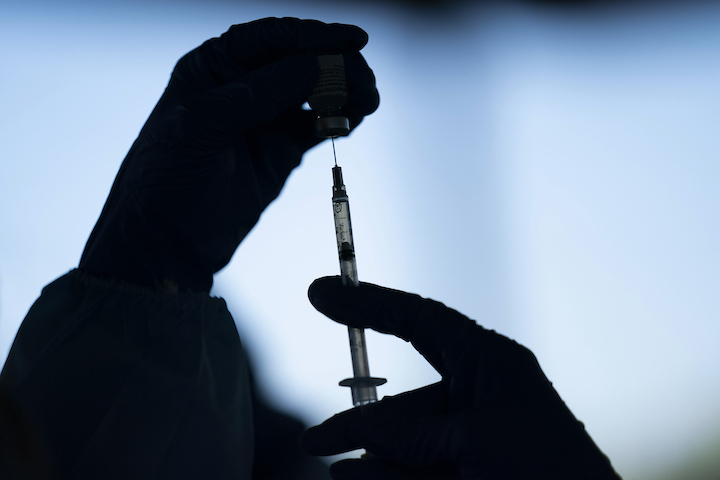How COVID-19 Vaccine Misinformation Uniquely Affects Communities of Color: A Conversation with Nora Benavidez

Photo by AP/Jae C. Hong
Misleading information, anti-vaccine propaganda, and conspiracy theories about the safety and efficacy of the COVID-19 vaccine continue to threaten public health, as well as our trust in our institutions and each other. While Black and Brown communities are now receiving the coronavirus vaccine at higher rates than in previous months, disinformation about the COVID vaccine, inequities in its distribution, a lack of access to credible news and medical advice, and the United States’ failure to adequately address medical concerns in communities of color are all representative of how our systems have failed these groups.
 Here to unpack these concerns and explore best practices for restoring trust, Nora Benavidez (PEN America’s director of U.S. Free Expression programs) offers practical steps that individuals and communities can take to evaluate online information, challenge misleading narratives, and revitalize the flow of accurate information online.
Here to unpack these concerns and explore best practices for restoring trust, Nora Benavidez (PEN America’s director of U.S. Free Expression programs) offers practical steps that individuals and communities can take to evaluate online information, challenge misleading narratives, and revitalize the flow of accurate information online.
Why is COVID-19 vaccine disinformation dangerous?
Vaccine disinformation is dangerous because it can alter our perceptions and our behaviors, leading us to make a set of decisions based on falsity. COVID vaccine disinformation is particularly dangerous because it can lead one to think the vaccine is bad, when in fact it is our best hope in returning to any semblance of normalcy. All of the decisions that we make in our daily lives are affected by the way we trust or do not trust the information we encounter. And the danger is not just for you—it’s for everyone around you too. The communities we live in are all at risk of falling prey to the things that we fall prey to.
How does COVID-19 vaccine disinformation spread online?
One of the greatest problems we see is that a majority of Americans read what their small circles post online as their main source of news. The problem with this is that most people are not fact-checking each other; they are merely interpreting that information as true. We also know that misinformation profits greatly on social media platforms because misleading information drives engagement. The greater the controversy, the more engagement and impressions a piece of content will get, so there is also an incentive on platforms to promote misinformative content.
“All of the decisions that we make in our daily lives are affected by the way we trust or do not trust the information we encounter. And the danger is not just for you—it’s for everyone around you too. The communities we live in are all at risk of falling prey to the things that we fall prey to.”
What are some of the leading false narratives about the COVID-19 vaccine targeting communities of color?
The narratives have changed, and one of the larger lessons here is that disinformation mutates quickly. Initially, there was a lot of concern in communities of color about whether the COVID vaccine would be effective, because of our long history in the United States of using Black individuals in scientific research experiments. Now, people are starting to speculate about the COVID vaccine’s side effects.
For example, one concern is whether it will affect women’s fertility. In Latino and Spanish-speaking communities, there have been stories that the vaccine uses stem cells, and therefore “pro-life influencers” have called into question whether this is a vaccine people should be taking. Over the many months ahead, we’ll see new emerging threads where disinformation will make people doubt—as the intent of disinformation always is—our institutions and each other.
During a panel discussion we at PEN America held back in March, Jacquelyn Mason from First Draft explained that even if vaccine distribution is inequitable and communities of color are not receiving it, that doesn’t mean they’re not receiving it exclusively because of their hesitancy to get it. Jacquelyn was trying to counter the false media narrative that people of color don’t want the vaccine—they do. We have to be careful how we read headlines, and we have to be careful not to simply talk about the hesitancy of these communities as the only story.
“Misinformation profits greatly on social media platforms because misleading information drives engagement. The greater the controversy, the more engagement and impressions a piece of content will get, so there is also an incentive on platforms to promote misinformative content.”
Given all of this, what are some of the best practices for restoring trust in these communities?
It’s challenging to think about how media literacy can be a perfect solution for everyone because everyone is different. Even lumping different AAPI communities within that title, or different Spanish language origin communities into a Latino or Latinx title, can be problematic. We can’t call all communities of color a monolith.
In our Knowing the News project, PEN America promotes media literacy principles and concrete actions people can take to stop the spread of misinformation. Talking about the complexity of the COVID vaccine is a simple first step. We should be talking about the reality that many people have questions about the efficacy of the vaccine, and we should consider the underlying historical reasonings for vaccine hesitancy. We should bring medical experts and trusted sources in to educate people about the COVID vaccine and talk with those who may either be considering it or who may be wary of it.
We also try to teach people to slow down and question what they see online. Instead of immediately trusting social media content that gets the most likes, shares, or comments, we encourage people to put what they heard or saw into perspective and think about the sources where this information comes from. For friends or family members that may be more resistant to the COVID vaccine, it’s also important to say, “You’re right to question it. In no way do I oppose questioning, I question a lot of things too.” Even though it may sound corny, I truly believe individual empowerment is part of what will help.
“Even if vaccine distribution is inequitable and communities of color are not receiving it, that doesn’t mean they’re not receiving it exclusively because of their hesitancy to get it. . . . We have to be careful how we read headlines, and we have to be careful not to simply talk about the hesitancy of these communities as the only story.”
We’re all publishers, and we all have a choice. In our own tiny microcosms, we can be the voices that help clarify for our friends and family what is false and what is scientific fact. If we all came to the online realm thinking about how to share fact-checked information and how to carefully engage with someone who is spreading misleading content, I think we would have a richer online environment—one less full of hate and lies—and where you can ask a question without someone attacking you.
Dr. Olveen Carrasquillo, who also joined us for our recent panel discussion, mentioned that he hopes we can get beyond talking about just COVID disinformation, because there are many other forms of health disparities facing communities of color, and he expressed that maybe this pandemic can be an opening to talk about health disparity generally. We may be in a position, post-pandemic, to look at the other disparities and say, for example, “Why is it that diabetes is more common in Black communities?” And in asking those questions, COVID can not only become a chapter that we successfully close, but can also open doors for critiquing how our systems have failed communities of color in other instances.






